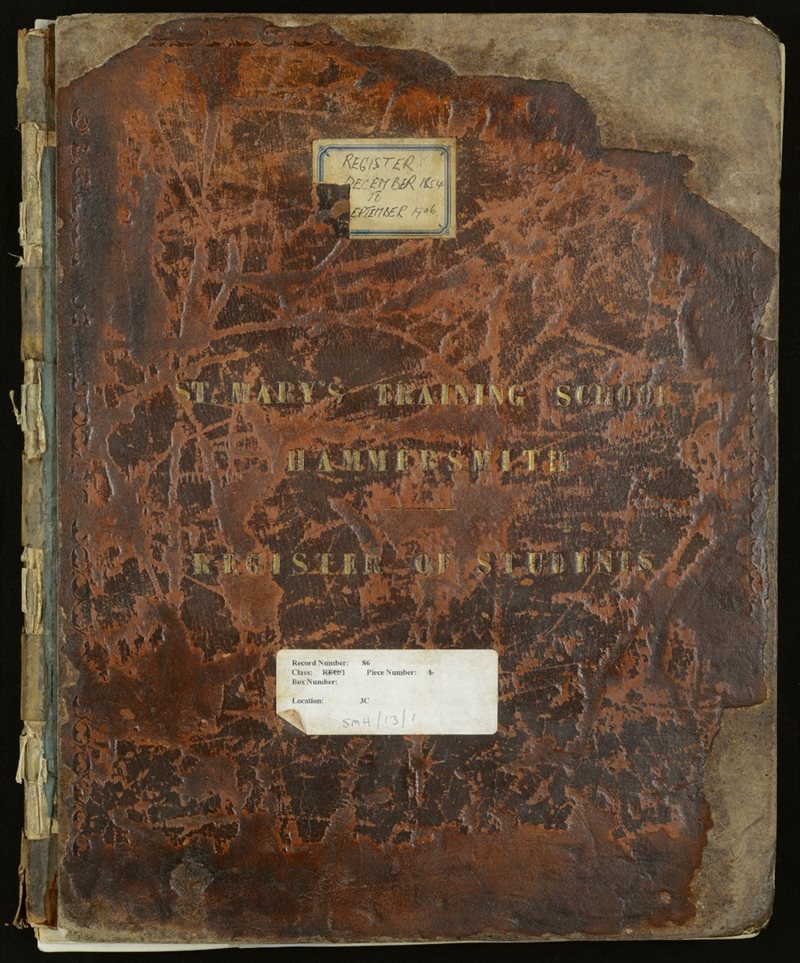The student body demographics of St Mary’s in the nineteenth century indicate the changing nature of Catholic society and the educational landscape in Britain, and the colleges' position within this. The nature of the student body is also important for learning about the character of the college.
In these efforts, researchers are well-served by the various pupil lists compiled in both primary and secondary documents. The Centenary Record of 1950, a published history of the college, is particularly useful for this in listing all known students up to that point. A copy in the St Mary’s archives is usefully annotated and corrected. This source is drawn in large part from the Registers of the college, these were kept in two large bound volumes from 1854-1906 and 1907-1929. They record the student's date of entrance, name, address, date of birth, previous occupation, date of leaving, exam results and remarks, in varying detail over time. Additionally, there are reports, letters and other documents within the Principal’s correspondence and papers which highlight the numbers and backgrounds of students.

Registers. Image courtesy of St Mary’s University Archives. Not to be reproduced without permission.
St Mary’s was initially founded in 1850 by the Catholic Poor School Committee to train male Religious teachers. This is a history that has been well-told elsewhere. By 1854 uptake had been so slim that the doors were opened to lay pupils. The lack of appeal of religious life perhaps reflects the wealth of other opportunities available to men in nineteenth-century Britain, compared to women who joined orders in larger numbers.
Despite opening admissions to lay students, applications, and admissions, remained much lower than hoped for. Twenty-eight students were in residence in 1857 and though numbers briefly improved, in 1860 there was a dramatic fall to just seven students entering the first year. This appears to have precipitated a period of significant struggle to get enough students, and making sure they were suitable. The issue was pressing enough in 1861 for Principal Rowe to draft a letter, of which fair few copies were presumably sent, to school managers on the matter. He called for their:
"assistance so far as to bring under my notice any young men of not less than 18 years of age who may be known to you as desirous of being trained for service in our Schools… the difficulties to be encountered at St Mary’s are as you are aware are very considerable."
St Mary’s, it seems needed both quantity and quality. Efforts to secure good candidates continued over the coming years, with limited success. The 1869 Returns for St Mary’s record that 211 students had been received at the college, excluding those currently enrolled, since ‘establishment’ in 1854. Over sixteen years this equated to thirteen students a year. Not all made it through and went on to carry out the purpose for which they had been trained. The Return gives just 139 of these students who were ‘known to be acting as teachers of Elementary Schools in Great Britain’. Altogether the numbers had been poor, though the same report shared that there were fifty students in the present academic year, which suggests numbers were improving. The next available Returns from 1873 recorded a slight uptick to fifty-three present students and those 326 students had been trained at the college together. In the intervening four years St Mary’s had received 115 students with an average of twenty-nine a year. The numbers it seems remained steady over the next few years. Though figures dropped to only 39 students in residence in 1878, this was apparently an anomaly.
The experiential background of students around this time was also changing. Of the fifty students in residence in September 1869 just over half had been Pupil Teacher. Four years later forty-three out of fifty-three had been Pupil Teachers. This trend toward greater applicants from, or perhaps greater preference of, Pupil Teachers continued. Internal notes compiled in the early 1890s and found within the Principal’s papers give statistics from the previous ten years with 95% of the intake across this period apparently Pupil Teachers. In around a quarter of a century since 1869, the balance had shifted from a slight outnumbering of Pupil Teachers to their peers to a near monopoly. This potentially reflects greater applications from a higher ‘class’ of candidate, the term used in the 1890s note, working towards the ambition Rowe had set out for the college in the 1860s. That even some full teachers were now joining the college as students indicated the perceived value of St Mary’s to status and pay checks. Slowly it seems St Mary’s was solving both its quantity and quality problems.
Where geographically did students come from? In the early 1890s, their places of origin were calculated as being:
- 54 from South Lancashire District
- 13 from Glasgow district
- 9 from Metropolitan district
- 23 from the rest of England.
These backgrounds need more exploration regarding the actual locations, ancestry, and class of pupils. However, the strong Lancashire character of the student body in this period is borne out elsewhere in the records. The college song, as recorded in 1910 began.
"I am a simple country yokel
and from Lancashire I came
came down by excursion train
to see the sights of London town".